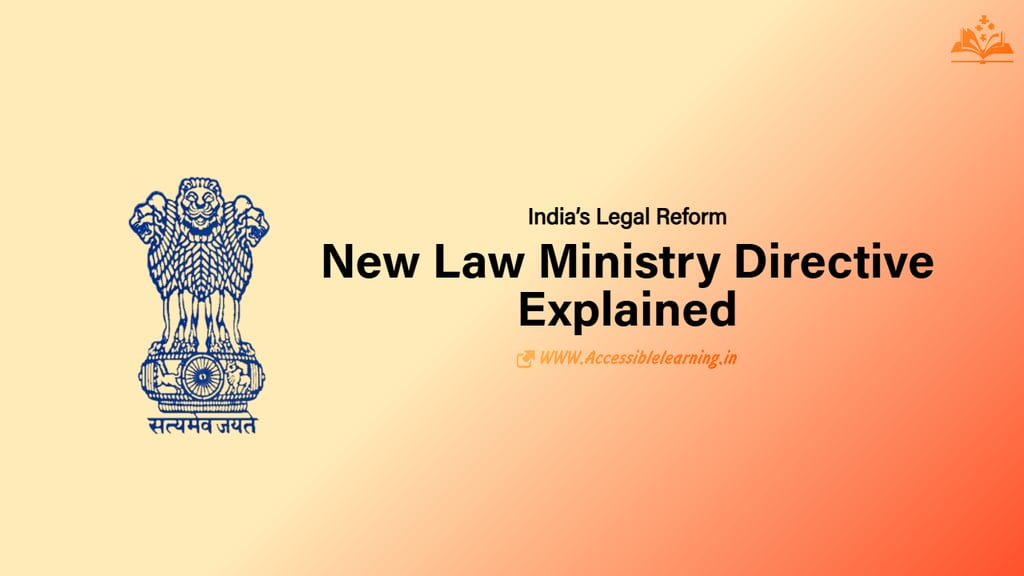
Ministry of Law Issues Directive to Minimize Litigation Involving Central Government
The Ministry of Law and Justice has issued a directive urging central government departments and PSUs to minimize avoidable litigation. This reform aims to promote responsible governance, reduce court backlogs, encourage dispute resolution, and improve public service delivery in India.
NEWS/CURRENT AFFAIRSNEPOTISM/SOCIAL ISSUESINDIA/BHARAT
Keshav Jha
4/16/20254 min read


A Step Towards Responsible Governance, Legal Efficiency, and Judicial Decongestion
In a landmark move to reshape how the Indian government handles disputes, the Ministry of Law and Justice has issued a comprehensive directive to all central government ministries, departments, and Public Sector Undertakings (PSUs) with a clear objective: cut down the overwhelming volume of litigation in which the Union Government is involved.
This is more than a policy update—it’s a call for cultural change across government systems, encouraging conflict resolution over confrontation and proactive governance over reactive legalism.
Background: The Government as a 'Compulsive Litigant'
For decades, the Indian judiciary has been flooded with cases where the government itself is one of the litigants. Reports from the Law Commission of India and the Department of Justice highlight a staggering reality:
Nearly 46% to 50% of all pending cases in Indian courts have the Union or State Government as a party.
A 2018 report estimated that the Central Government alone spends thousands of crores annually on legal battles, many of which involve routine service matters, land disputes, and tax appeals.
Most of these litigations are repetitive or frivolous, clogging up courts and wasting taxpayer money.
The Supreme Court has often remarked on this trend, even dubbing the state a “reluctant litigant” and a “selfish litigant,” more focused on defending bureaucratic decisions than resolving disputes amicably.
What the New Directive Says: Key Provisions
Thorough Pre-Litigation Review
All departments must now institute compulsory internal vetting committees to review:
The merit of filing or defending a case.
Whether the issue at hand has already been settled by higher courts.
Alternatives to litigation, including arbitration, conciliation, or settlement.
Centralized Litigation Management Units (LMUs)
Every ministry will form an internal Litigation Management Unit, headed by a joint secretary or senior officer, responsible for:
Tracking ongoing litigations through legal dashboards.
Ensuring compliance with court timelines and avoiding contempt.
Sharing data with the Department of Legal Affairs in real time.
Discouraging Appeals Without Justification
One of the most frequent issues is automatic appeals even in low-value or settled matters. The new policy instructs legal officers to:
Avoid routine appeals in service cases or tax disputes where Supreme Court precedents exist.
Factor in the cost of litigation versus expected benefit before proceeding.
Promoting Alternative Dispute Resolution (ADR)
Departments have been asked to prioritize ADR mechanisms like
Lok Adalats
Mediation cells
Arbitration panels, particularly in infrastructure and commercial contracts
This is especially crucial for PSUs, which often face commercial disputes with vendors, partners, and service providers.
Litigation Avoidance Protocols
The Ministry of Law has emphasized the adoption of “Litigation Avoidance Protocols,” such as
Periodic inter-departmental consultations before decisions that may lead to legal challenges.
Policy clarity in contracts and tenders to reduce scope for interpretation-based disputes.
Legal audits of high-risk projects to identify and defuse potential conflict zones.


Why This Matters: Implications and Outcomes
Judicial Decongestion
Reducing government litigation could free up thousands of court hours, allowing judges to focus on criminal justice, women’s safety, and economic offenses.
Better Public Service Delivery
Departments bogged down by legal entanglements often fail to deliver on their core mandates. Reducing litigation would streamline public service mechanisms, especially in sectors like employment, pensions, and land acquisition.
Cost Savings
A reduction in cases could save crores in legal fees, bureaucratic resources, and compliance costs—freeing funds for development priorities.
Improved Ease of Doing Business
India’s rank in global Ease of Doing Business indices has often been hurt by contract enforcement delays. With faster dispute resolutions, investor confidence could significantly improve.
Boost to Trust-Based Governance
When citizens see the government stepping back from unnecessary legal confrontations, it fosters public trust and institutional respect.
Supporting Frameworks and Past Initiatives
This directive is not standalone—it builds on a series of past initiatives:
National Litigation Policy (2010): Called for the government to be a “responsible litigant” but lacked implementation teeth.
Legal Information Management and Briefing System (LIMBS): A digital tool to track cases across ministries.
eCourts Project: Strengthening court infrastructure to track and manage caseloads.
Department of Legal Affairs Guidelines (2022): Promoted ADR and asked departments to refrain from filing repetitive appeals.
However, lack of accountability, poor monitoring, and siloed legal cells meant earlier efforts didn’t translate into tangible change. The 2025 directive intends to correct that by putting stronger accountability systems in place.
Expert Opinions and Reactions
Legal Experts say
“This is long overdue. Most government cases shouldn’t be in court to begin with. A proper implementation of this directive could reduce at least 20–25% of caseloads within two years.”
— Justice (Retd.) A.P. Shah
Policy Think Tanks observe
“Litigation should not be the first reflex of governance. This policy is a cultural shift, not just a procedural one.”
— Centre for Policy Research (CPR)
The Ministry of Law’s directive to minimize litigation is a step in the right direction—a genuine attempt to make the government less adversarial, more efficient, and more empathetic. If followed in letter and spirit, it could usher in a new era of cooperative governance where disputes are seen as opportunities for resolution rather than battlegrounds for assertion.
But the true success of this directive will depend on
Follow-through by individual departments
Strong inter-ministerial coordination
Public transparency and reporting
As India pushes for a New Legal Order—one that aligns with global best practices—this initiative could be a defining milestone.
Subscribe to our newsletter
All © Copyright reserved by Accessible-Learning
| Terms & Conditions
Knowledge is power. Learn with Us. 📚


